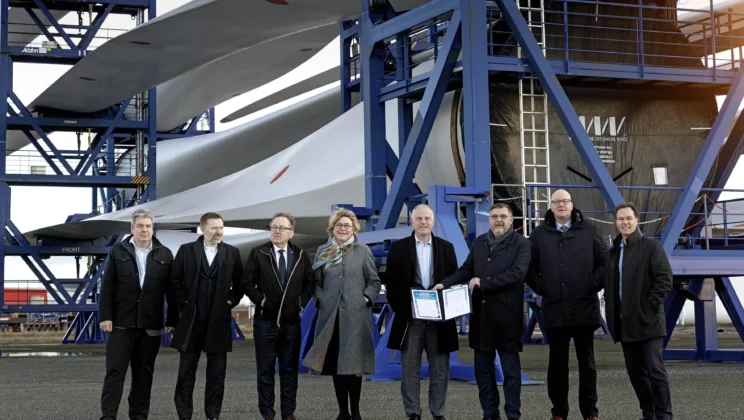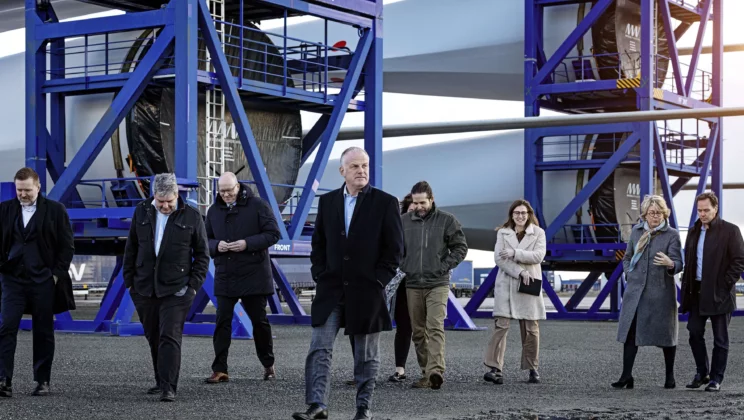European decisions call for a sharp increase in the pace of offshore wind installations. This puts a lot of pressure on ports. That is why Port Esbjerg took the initiative to collaborate with the other five leading wind installation ports in northern Europe; the ports are normally competitors but they have already started working closely together to optimise capacity. What is more, Port Esbjerg is encouraging others in the maritime sector to do the same to meet the ambitious offshore wind targets.
There were smiles all around, thumbs up and high spirits, as a tour of the harbour at Esbjerg ended with a photo session. The date was 18 January and the smiles belonged to the representatives of the six ports involved in a ground-breaking new collaboration between Europe’s largest offshore wind installation ports.
The agreement was signed on the day and the first discussions on the collaboration were held. In addition to the initial discussions, the agenda also included a talk by Harvard professor Willy Shih who spoke on logistical challenges.
Fivefold increase in offshore wind in eight years
The current EU target is to install at least 65 GW of offshore wind by 2030. A high number. Not least considering that there is currently just over 13 GW in the seas around Europe. In other words, the EU aims to install well over five times as much offshore wind in the next eight years as we have built during the previous twenty.
By 2050, the plan is to have installed 340 GW.
‘Fit for 55’ is the EU’s climate package which makes the commitment to reach the climate target of reducing the EU’s emissions by at least 55 per cent by 2030. To achieve that goal, offshore wind is crucial.
With the Esbjerg Declaration of May 2022, the target for offshore wind in Europe was increased dramatically. Since then, ambitions have grown even further. This is the equivalent of installing 24,000 of the currently largest turbines.
“These are obviously ambitions that we appreciate and support at Port Esbjerg,” says Dennis Jul Pedersen, CEO of Port Esbjerg.
However, it puts huge pressure on European installation ports, because without installation ports, there will be no offshore wind farms.
The current geopolitical situation in Europe with war in Ukraine has added further pressure.
Collaborating to ease pressure on ports
Right now, ports lack the capacity to deploy about 30 of the 65 GW. Out of thousands of existing European port terminals, Vestas maintains that, by 2025, there will only be fourteen quay areas in twelve installation ports with enough space to accommodate the ever-larger wind turbines planned to be built at sea.
These factors contributed to Port Esbjerg taking the initiative to collaborate with five of the port’s usual competitors, as they are five of the most important installation ports for offshore wind in northern Europe.
And so the parties met at Esbjerg on 18 January to sign a declaration of collaboration and get to work straight away.
“We’ve done this to try and support European wind ambitions as quickly as possible. It’s necessary that we, as Europe’s leading offshore wind ports, establish partnerships that contribute to knowledge sharing and best practice, while obviously respecting competition legislation,” says Jul Pedersen.
The ports are Port Esbjerg in Denmark, Port Oostende in Belgium, Groningen Seaports/Eemshaven in the Netherlands, Niedersachsen Port/Cuxhaven in Germany, Port Nantes-Saint Nazaire in France and Humber in the UK.

On January 18, representatives from the six installation ports met at Port Esbjerg to sign a declaration and begin the work immediately.
Why collaborate?
The collaboration will cover a number of areas.
If one port only has space for half an installation project, another port may have space for the other half. The ports will share knowledge and planning and increase the transparency of their work in all possible ways. They will also ensure optimal processes and share digital experiences. Port Esbjerg has just had a digital tool developed – a so-called digital twin – to help triple its capacity of offshore wind in the future, without having to expand the harbour. This kind of experience needs to be shared, so the ports can utilise the capacity and skills wherever available.
The collaboration between the installation ports will also support the political efforts at EU level to provide the best possible framework for the ports to achieve the ambitious offshore wind targets.
“Even though our ports compete with each other, we still face the same challenges and have a joint responsibility to shape the future,” says Jul Pedersen.
See more about the collaboration between the six installation ports here.
The collaboration has been well received.
“The importance of European ports shouldn’t only be measured in tonnes, but should also be assessed on their contribution to the supply and deployment of energy, especially renewable energy. I’m very excited that these six important wind energy ports are joining forces and taking the lead to meet the EU’s ambitious offshore wind targets. We tackle challenges more easily by working together,” says Isabelle Ryckbost, Secretary General of the European Sea Ports Organisation (ESPO).
WindEurope estimates that without additional investment at the installation ports of EUR 6.5 billion in the offshore wind sector, we will not be able to meet national and international targets.
“Reinforcement of heavily loaded quaysides, deepening the fairway and other civil engineering works are needed. By strengthening the collaboration between the ports, we can do the groundwork that’ll lead to future expansions and sufficient capacity,” explains Jul Pedersen.
The collaboration partners are also positive.
“We’re now joining forces to find the best solutions for optimising the ports in the offshore industry. Collectively, we can be regarded as serious partners in achieving the European targets,” says Erik Bartholet, Business Manager, Logistics and Offshore Wind of Groningen Seaport/Eemshaven.
Germany has set a target of 30 GW offshore wind capacity by 2030, 40 GW by 2035 and 70 GW by 2050. When you view this in the context of the combined European targets, it is obvious that achieving the targets requires a joint and coordinated effort, according to Holger Banik, Managing Director at Niedersachsen Ports GmbH & Co:
“The green transition poses an enormous challenge for all European players in the offshore industry, so a stable alliance is key to success. Even though we are competitors, we still face the same challenges and have a joint responsibility,” says Banik.
Green Port Hull is delivering on the British government’s offshore wind target of 50 GW, and Siemens Gamesa continues to drive growth by doubling the capacity at its offshore blade manufacturing facility in Hull, as the world’s largest offshore wind farm, Hornsea Two, gradually comes online off the east coast of England.
“As of today, we’re collaborating with competing ports. This isn’t something we usually do in this industry. So now we can start to map out how we can put the pieces of this puzzle together to make our overall capacity bigger. I think this partnership has already proved to be fantastic and has provided an understanding of what plans the other ports have going forward,” says Andy Reay, Head of Offshore Wind, Director at Renewable UK.

A tour of the port. Isabelle Ryckbost, Secretary General of the European Sea Ports Organisation (ESPO), also joined on January 18 when the six ports signed the declaration.
Follow our example
The six ports also want to lead by example. If the ports are to succeed in their ambitious offshore wind targets, the collaboration of six installation ports is simply not enough. Other players in the maritime sector need to create similar forums, where coordination across both industry and geography can help push the boundaries of what is possible.
“The maritime sector needs to be more transparent, improve its communication and coordinate better in order to enable ports, vessels and manufacturers to optimise processes to accelerate the green transition. Only then will it be possible to meet the targets of the new European offshore wind strategy. We therefore hope that our collaboration will be the starting shot for more of the same,” concludes Jul Pedersen.
The plan is for the installation ports to meet twice a year and hold planning meetings in between.
Go to overview

